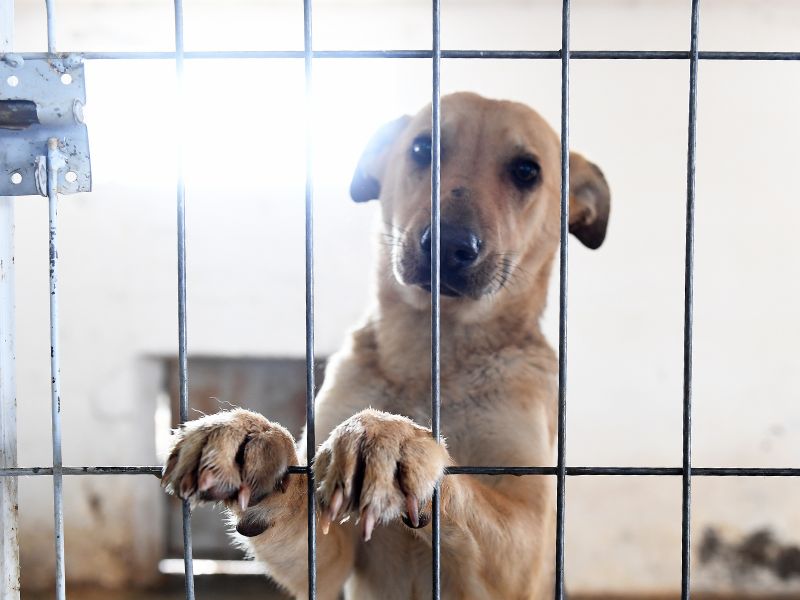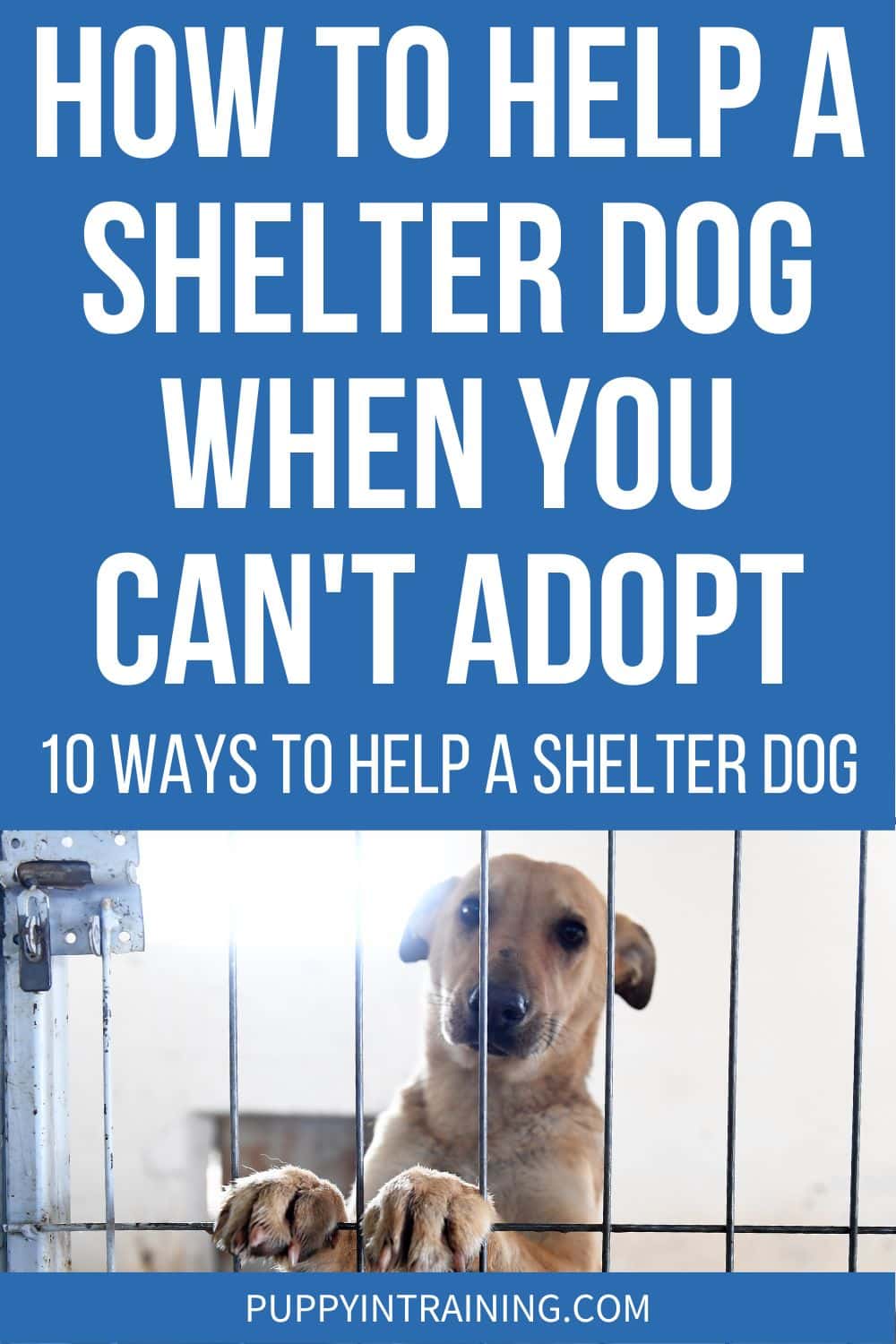How To Help A Shelter Dog When You Can’t Adopt
This post may contain affiliate links. We may earn money or products from the companies mentioned in this post.
So you want to help a shelter dog but aren’t able to adopt. You may already have a canine companion who won’t welcome another dog. Or you may not have the time or resources to adopt.
Whatever the reason, there are many other ways you can help shelters and their dogs.
I’ve been associated with a shelter for many years teaching classes and as a recommended trainer.

I even adopted one of my rescues, a Lhasa I named Mikey, from that shelter. I’ll tell you more about him later.’
But there are many actions I’ve taken to help the rescue too because my pack is full and I’m unable to adopt right now. I’ve taught free classes for their staff and volunteers. And I’ve supported their fund-raising efforts.
Anything that helps more dogs (and cats) get adopted is appreciated by a rescue organization.
After all, the staff of most shelters are very dedicated to saving lives. So any support towards those efforts helps the cause.
How To Help A Shelter Dog When You Can’t Adopt
In this blog post, I’ll describe many ways that you can help dogs get adopted even if you’re unable to adopt yourself.
Volunteer Fostering Dogs
If you can’t commit to adopting a dog but love canine companions, you may be able to foster a dog.
Fostering involves taking a shelter dog for a limited period to help him become more adoptable.
Some dogs are fostered until they find a “furever” home. And others are just given a break from the shelter for a limited time, then returned there.
Many dogs in shelters suffer from shelter stress when in that environment long-term.
The noise, lack of enrichment activity or exercise, and confinement is too much for many dogs. So their behavior may deteriorate and they may become reactive or aggressive, thus becoming less adoptable.
Fostering helps relieve that stress. And many foster homes provide training, exercise, enrichment, and love to the rescue.
Many shelters provide training and ongoing support.
The shelter I’m associated with has an exceptional foster program. So many dogs are more adoptable after being in one of their foster homes.
The foster dog learns how to “be a dog” in a real home. He receives positive attention, mental and physical exercise, and a routine in a secure environment.
The dog can learn how to walk on a loose leash, not jump on people, and basic cues such as sit and down. And even a trick or two. After all, who can resist a dog who shakes hands?
Many years ago, I fostered a Pekingese named China. The rescue she came from indicated that she was aggressive.
But once China was out of the shelter environment, she was a different dog. She was sweet and showed no aggression or reactivity.
I worked with some basic cues such as come, sit, down, and loose leash walking. I played fetch with squeaky toys, which she loved. She would pounce on them and then toss them in the air. So cute!
China loved the attention and was a quick study. Within weeks, she found a permanent home.

China the Peke
Fostering really does save lives. When a foster home takes a dog in, the shelter has room to save another life. Some shelters–such as rural ones or even in some big cities–may have low adoption rates.
Many shelters provide foster homes with all they’ll need for the dog, such as food and vet care. But some don’t have the resources to do so.
Considerations When Deciding Whether or Not to Foster
When deciding whether fostering is right for you, consider whether:
- You have the financial resources to foster, including food, treats, vet care, crate, bed, leash, harness, collar, cleaning materials
- You’re ready for the extra work involved for a foster dog, including grooming, training, exercise, and cleaning
- You have the time to foster
- Your family members are on board with fostering
- Your other pets will get along with the newcomer
- The rules of your township, city, state, or living quarters allow the number or type of dog you will foster
- You are emotionally prepared to give the dog back to the shelter or to a new home
Volunteer at the Shelter Itself

There are many opportunities to volunteer at the shelter itself.
Shelters often need additional staff for many of their day-to-day functions. And they may not have the funding for all that needs to be accomplished.
So volunteers help fill the void. You can help with many of the following tasks at the shelter itself:
- Working at the reception desk
- Cleaning kennels
- Washing sheets and towels
- Preparing food and treats
- Walking dogs
- Taking dogs places
- Sending out mailings
- Bathing and grooming dogs
- Training or providing other enrichment to dogs
Volunteer Your Special Skills
If you have a special skill that can benefit the shelter, your assistance will be appreciated.
My first contact with the shelter I’m associated with over 20 years ago was by volunteering to help exercise and train dogs.
Walking the shelter dogs helped relieve some of their stress. And some basic training helped get some adopted.
I volunteered to help more dogs get adopted.
By doing so, I also found out about my first rescue, Mikey the Lhasa apso. Volunteering changed my life–and his.
Adopting Mikey led to me adopting more dogs. Mikey became the dog he was meant to be.
I taught him not to fear people. It took a lot of behavioral work and training, but he was worth it.
He became an ambassador for rescued dogs whenever we went places.
My dogs and I went on weekly socialization treks to shopping centers and pet stores.
Mikey learned to trust people. And he even enjoyed being petted and given attention by other people. Of course, the treats he was given didn’t hurt either.

Mikey the Lhasa
You may be able to take great photos of shelter dogs to help them get adopted.
You may have graphic skills to help design brochures and other documents that will make any event or dog stand out and be noticed.
You may have great media skills to post descriptions of dogs that will be noticed.
Or you may have great people skills and help with outreach activities. You get the idea.
Donate Items
Of course shelters always welcome monetary donations. But they also need many other supplies that you may have on hand and no longer need.
Our shelter always need many of the following items:
- Towels and sheets (even gently-used, clean ones are often welcome)
- Bleach
- Laundry detergent
- Toys
- Collars, leashes, and harnesses
- Food and treats
- Beds
- Dishes
- Grooming brushes, combs, and shampoos
- Cleaning supplies
- Newspapers
- Paper towels
Network Shelter Pets on Social Media
Many shelter pets find homes because they’re posted on various social media sites such as Facebook. An adorable picture and descriptive write-up helps dogs get adopted.
So if you’re on Facebook or other media sites recommended by your shelter, cross-posting these irresistible canines can really help them find a “furever” home.
I saw a photo of one of my rescues posted on such a site. Lady the sheltie looked so cute. And she resembled another sheltie I had named Amber who had passed away at 14 years old.
We went to see Lady. And it was a done deal. This senior sheltie came home with us the day after I saw her photo and write-up.
If she hadn’t been posted, I wouldn’t have known about her.
She was a sweet dog who loved everyone. Lady immediately got along with the resident dogs–even playing sheltie chase games with puppy Murphy.
She even later became a therapy dog at a hospital where I volunteered.

Lady the sheltie
And ask your friends to like and cross-post too. There’s power in numbers.
Help With Fundraisers
Attending fundraisers of course helps shelters raise money. Our shelter has many every year. It has luncheons, restaurant events, “Bark-in-the-Park” with many events, and more.
So get a group of your friends together and make it a fun outing while helping homeless animals.
Sell tickets to these events. Help run and set up the fundraiser. There are many avenues you can pursue to help rescue dogs.
Help Transport Dogs
Shelters need dogs transported to many events. So you may need to bring a dog to an outreach or similar event.
Or you may help by transporting dogs from other areas–including other states–to your local rescue.
Sometimes shelters have a van that does this and need help with the transport.
Other times individuals volunteer to pick up and transport dogs in their own vehicle part or all of the way to the ultimate destination.
Driving dogs to the vet or foster homes also helps the cause.
Take Great Care of Your Pets
By taking great care of your own pets, you ultimately help shelters by not adding more to their population.
So make sure that your dog is microchipped and wears identification. Then, should he become lost, you can get him back.
Don’t leave your dog unattended outdoors. Make sure any gate is locked so that he can’t escape through a door or fenced yard.
Keep him in tip-top shape by attending regular vet visits.
And last, but not least, spay and neuter your pet in accordance with your veterinarian’s recommendation.
Help Others
There are many ways that you can help others keep their dogs.
There are food banks for pet food and other supplies for people who can’t afford to feed their canine companions.
You can donate food, cat litter, or any other necessary supplies they need.
Some programs help people who need short-term housing for their pet. You can volunteer or provide funding to assist.
Adopt, Don’t Shop
Of course I believe in adoption. Many of my personal dogs were adopted from various shelters and rescue organizations.
My first rescue I discussed above was a stray Lhasa apso I named Mikey who was going to be euthanized for behavioral issues including aggression.
He ultimately learned to trust people. He also loved to learn and became a top obedience and rally Lhasa–something that no one would have thought possible when he was first brought to the shelter, defensive and scared.
Because I specialize in helping dogs with behavioral problems, I subsequently rescued others.
Linkin, a very abused Lhasa apso, joined our household.
He was almost feral when I adopted him. He would hide under furniture and wouldn’t allow anyone near him.
Over the months that followed, he learned to trust me. And even learned to play and come out of his shell.
It was great to see him not be so fearful that he felt that his only option was to lash out to protect himself.

Linkin the Lhasa
Others followed too.
My current rescues are a golden named Riley who had some resource guarding issues before I adopted him.
He’s a great dog who just needed some training, behavior modification, and the proper amount of physical and mental exercise.
I worked with his issues, walked him for miles, and socialized him.
He even got Canine Good Citizen titles as well as obedience and rally titles with many placements. He loves to learn and even to be in the show ring. He’s happy and loves life!

My other rescue is an Aussie mix named Millie. She was born in rescue after her mother was transported from Mississippi.
The rescue was very careful where the litter was placed. The mother looked like a purebred Aussie–a herding breed with drive and energy to spare.
Knowing how much time and training is required to properly raise herding dogs, the rescue screened all applicants.
They wanted people with herding breed experience so that the adopters knew what they were getting into. And not give the dog up.

Millie Aussie mix
For each one adopted, a shelter or rescue is able to save yet another life.
I do believe too in reputable breeders if someone wants a specific breed. But even then, about 25 percent of shelter dogs have been estimated to be purebred dogs.
And there are many rescue organizations that specialize in certain breeds.
FAQs
I can’t adopt a dog right now and my finances don’t allow me to donate to a shelter. Is there any other way I can help?
Yes! You can donate your time and skills to help with tasks that the shelter needs to be accomplished.
My local shelter is looking for foster homes. Will they teach me what I need to know to be a foster?
Many shelters have programs to teach you the skills that you need to foster a dog. And they provide ongoing support. Check with your local shelter regarding how their program is run.
I’m a photographer. How can I help shelter pets?
Many shelters welcome people with photographic skills to help take pictures of shelter dogs that stand out and show the dog’s real personality These photos are posted on the shelter’s website and social media. When the right individual sees a dog who appeals to them, it helps the dog get adopted.
Final Thoughts
Adoptable dogs are at a shelter through no fault of their own.
Sometimes people can’t keep their dogs for legitimate reasons or just couldn’t commit to the responsibility of owning a dog.
For whatever reason, the homeless waifs deserve a second chance. And there are many ways to help them other than adopting them.
Have you helped a shelter dog get adopted? Please tell us about in in the comments section below.
Save To Pinterest

Top Picks For Our Puppies
- BEST DOG CHEW
We Like: Beef Collagen Sticks - All of our pups love to bite, nip, and chew. We love using Collagen Sticks to help divert these unwanted behaviors. - BEST PUPPY TOY
We Like: Calmeroos Puppy Toy w/ Heartbeat and Heat Packs - Perfect for new puppies. Helps ease anxiety in their new home. - BEST DOG TREATS
We Like: Crazy Dog Train-Me Treats - We use these as our high-value treats for our guide dog puppies. - BEST FRESH DOG FOOD
We Like: The Farmer's Dog - A couple months ago we started feeding Raven fresh dog food and she loves it! Get 50% off your first order of The Farmer's Dog.
Check out more of our favorites on our New Puppy Checklist.